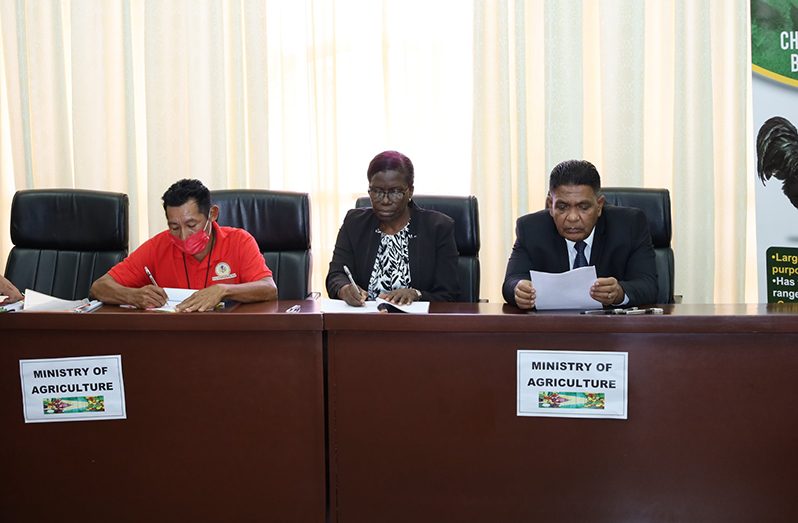ON the sidelines of the National Toshaos Conference on Wednesday, contracts valued $70 million to boost agricultural production in Region Nine (Upper Takutu-Upper Essequibo) were signed.
Toshaos and Deputy Toshaos from Amerindian villages across Guyana are currently in Georgetown for the conference hosted at the Arthur Chung Conference Centre (ACCC), Liliendaal.
The Agriculture Ministry, through the Hinterland Environmentally Sustainable Agricultural Development (HESAD) Project which is implemented by the Agriculture Sector Development Unit (ASDU), signed the contracts with various Amerindian village leaders.
Speaking exclusively with the Guyana Chronicle about the agreements which will boost the livelihoods and improve the economic standing of beneficiary communities, Chairman of that region, Brian Allicock, said that the ongoing and anticipated agricultural projects will not only earn revenue, but will also enhance food security.
“It’s a boost for us in terms of our food security… More so, the kind of interest that is paid in Region Nine’s agriculture [sic] development,” Allicock said.
Some major ongoing projects in the region are the large-scale production of corn and soya bean, rice and the newly introduced wheat production. For wheat specifically, the project will see 5,000 acres of land in the Rupununi area being utilized for the first outdoor trial of the grain.
“The major crops that we are looking at now [are] soybean, corn, rice, and we are going into wheat experiment and onion. So those are the areas that we are concentrated [sic] on,” the Regional Chairman explained.
Allicock noted that these projects will create employment opportunities for many persons in the region.
“A lot of people are happy about it. I am happy about that. We are able to have our people involved, and they are very happy because when these things start to materialize, a lot of people will be employed other than what they are doing now,” he said further.

Meanwhile, in relation to livestock, Allicock disclosed that the region is looking to improve its cattle rearing for beef production. The region has also begun the roll-out of its black giant bird project.
“We also have the black giant project that we have started and we will be issuing more chickens to other people… [This will be] between 15-20 per family who need to go into it,” the regional official added.
With this project, Allicock is hoping that the region can cut back on its importation of chicken from Brazil.
As regards the contracts signed on Wednesday, investment will be seen for the funding of public goods such as the village offices, rehabilitation of key buildings, and construction of bridges, access roads, and community centres, to name a few.
With the financing provided through the contracts, the business projects to be engaged in by the producer groups and villages are in areas focusing on cattle production, ranch improvement, poultry production, guest houses rehabilitation, and other-crops production.
These investments are intended to build village economies and provide incomes to the villages along with ensuring food security.
The villages that signed contracts are Karasabai, Kokshebai, Tiger Pond, Pai Pang, Taushida, Tipiru, Rukumuta, Yurong Paru, Fairview, and Shea.
Agriculture Minister Mustapha, during an earlier presentation at the conference, said that the ministry is committed to the development of all regions and villages in Guyana, inclusive of all Amerindian villages.
He further pointed out that each region has its own competitive advantage. The Ministry of Agriculture, he noted, will capitalize on this to expand agriculture in each region.
Since taking office in August 2020, the Ministry of Agriculture has expended over $2 billion on development for Amerindian villages across Guyana.



.jpg)








